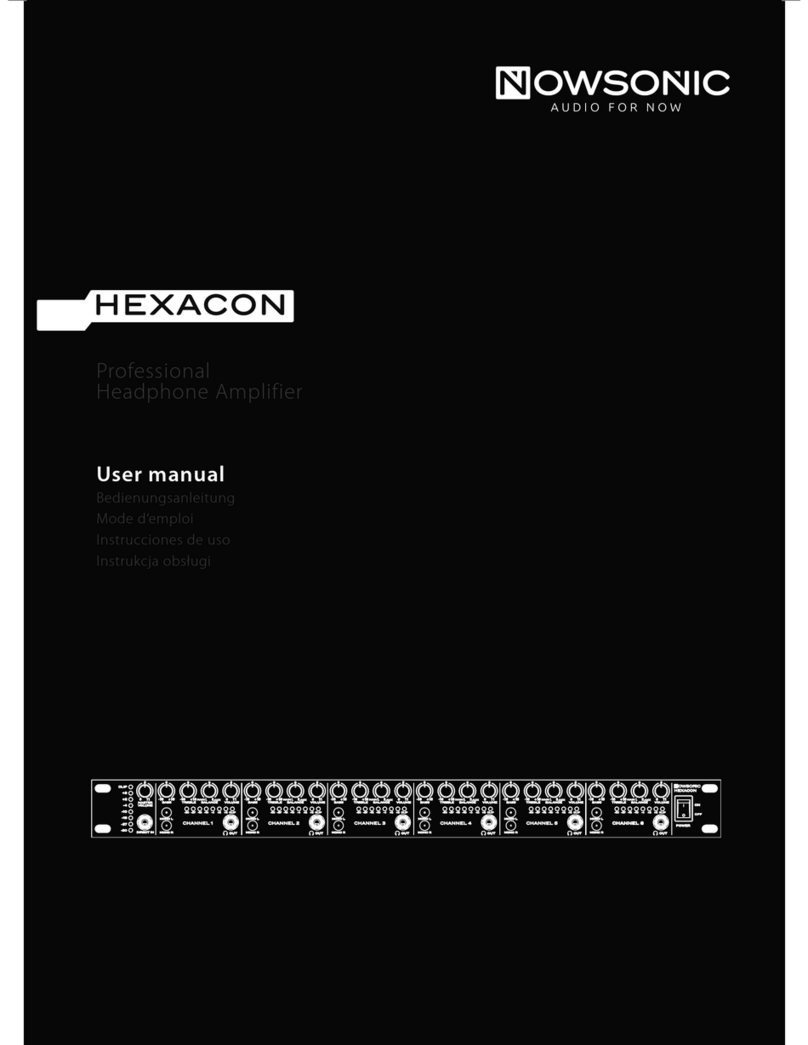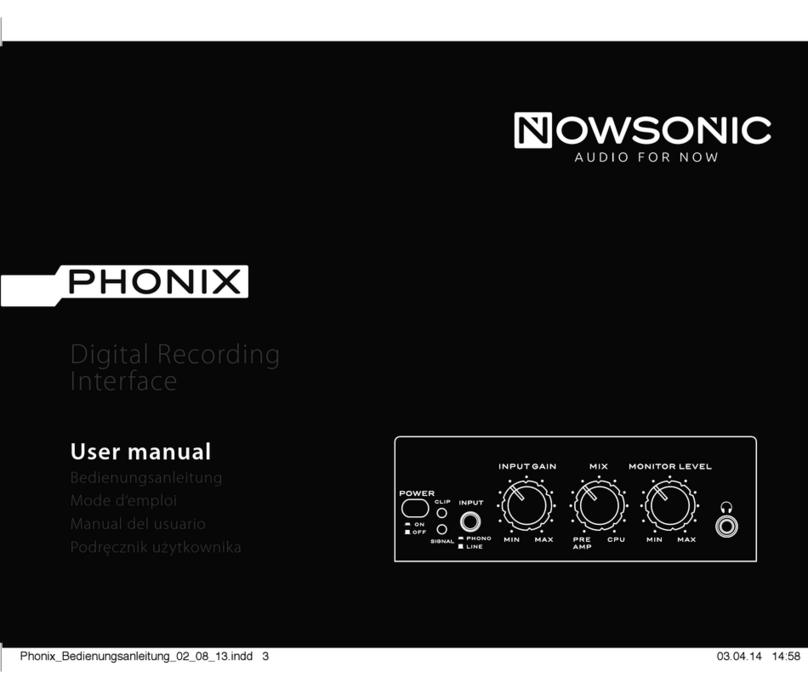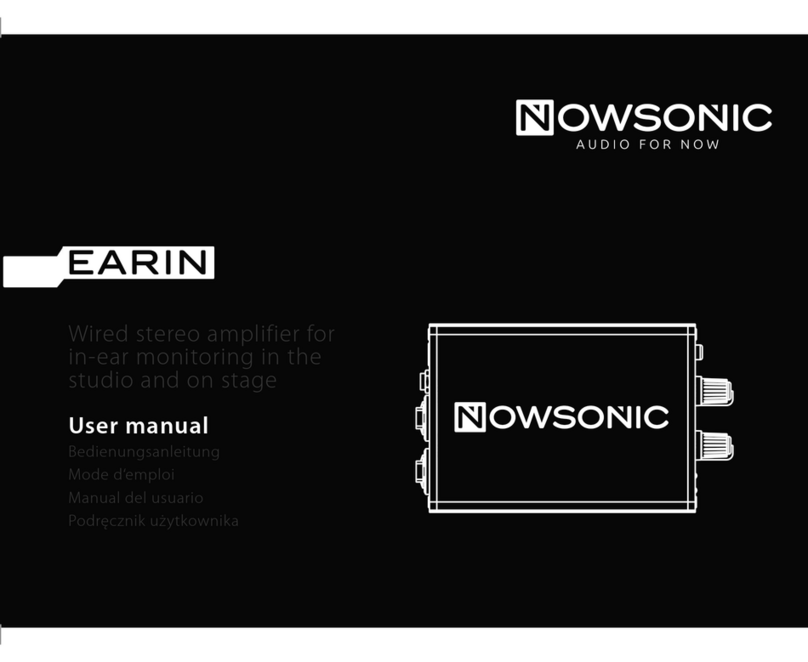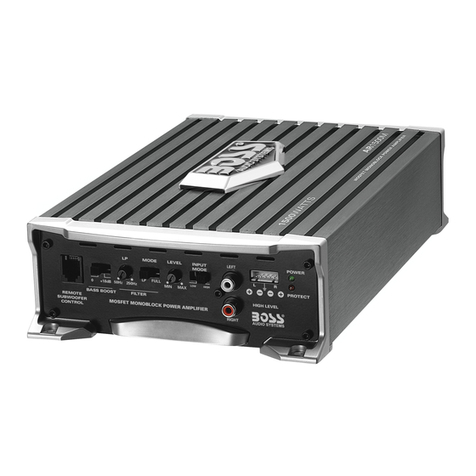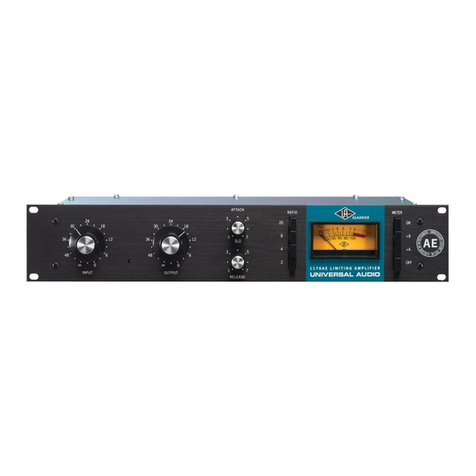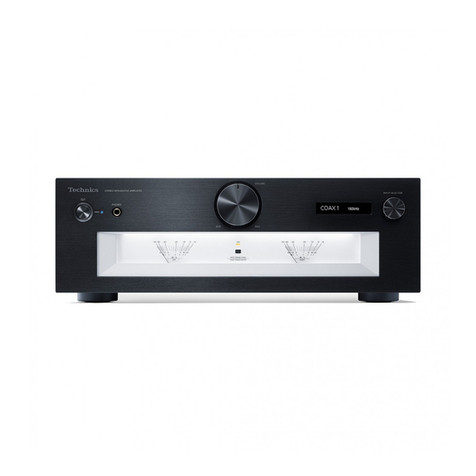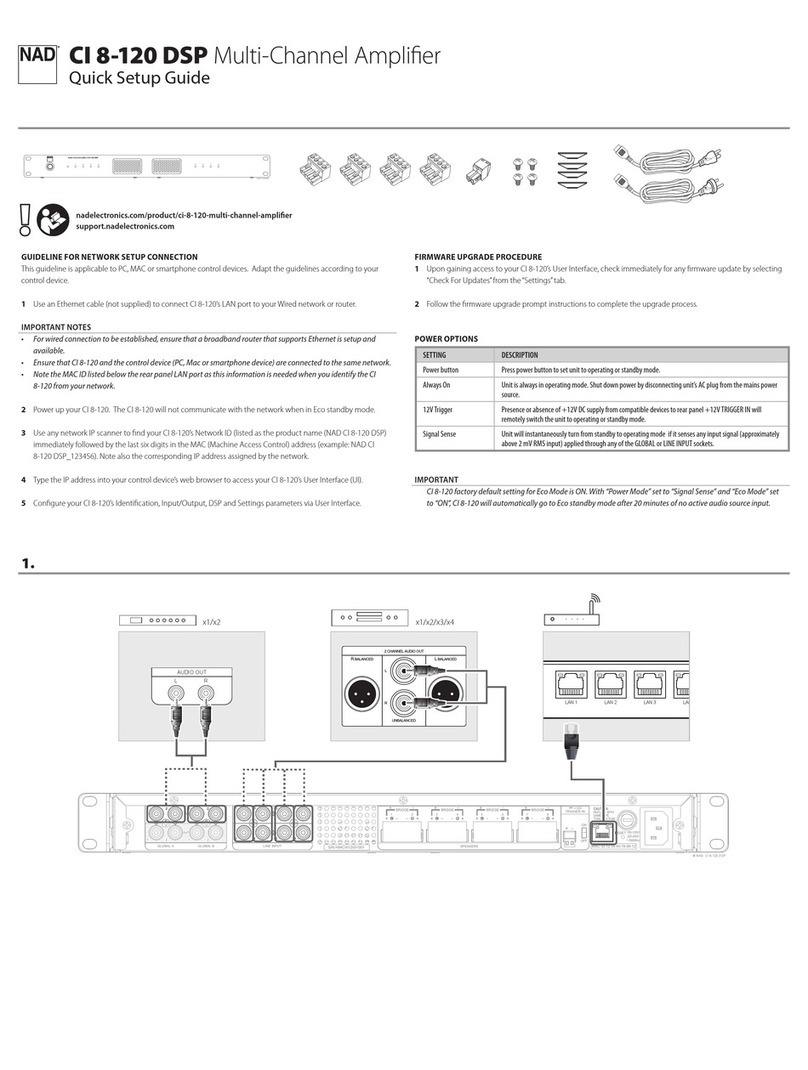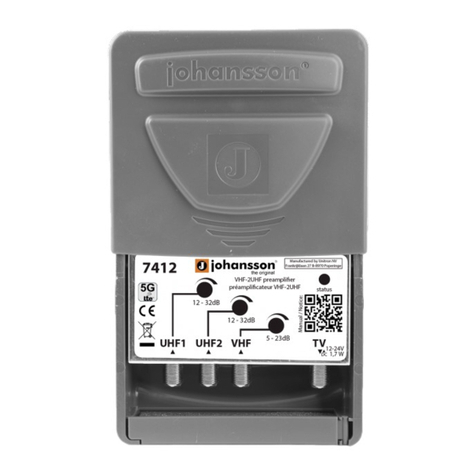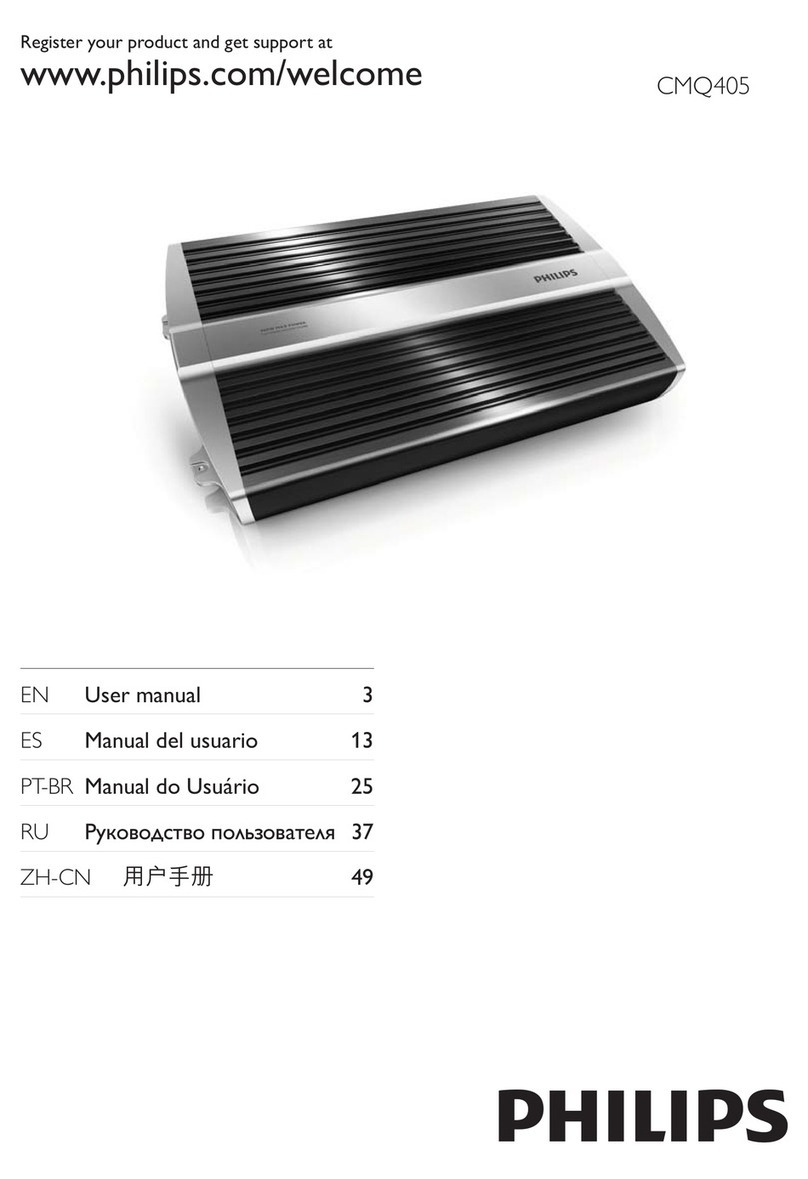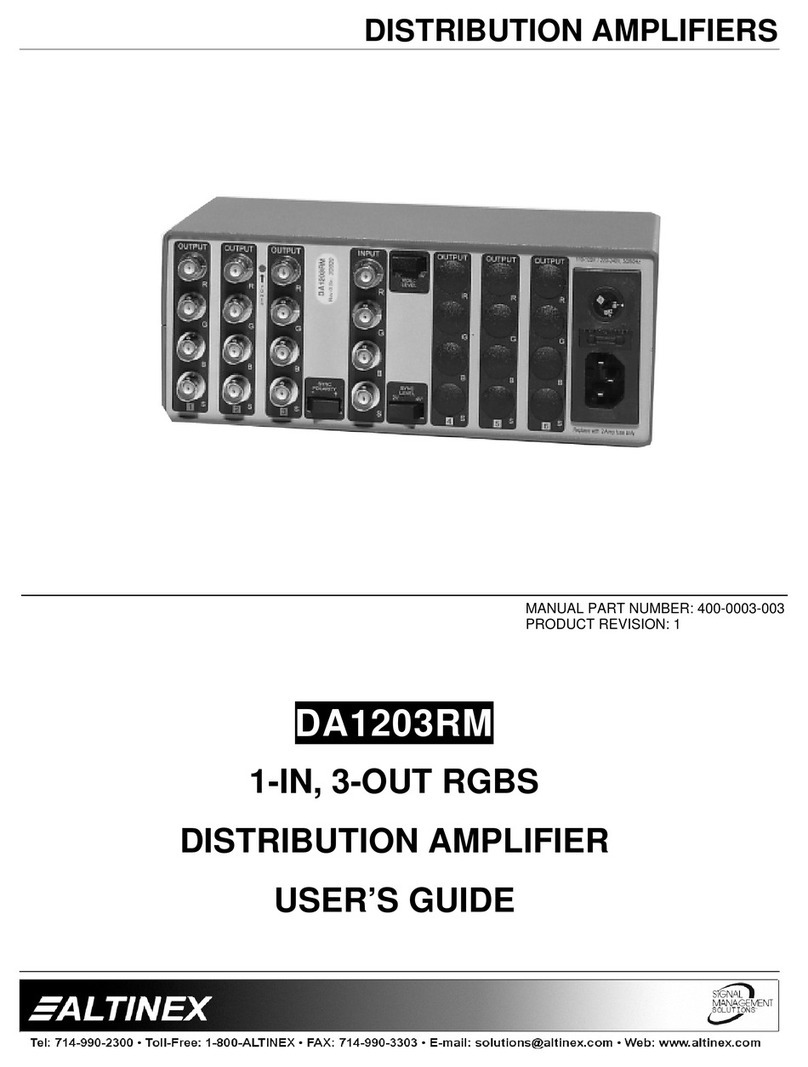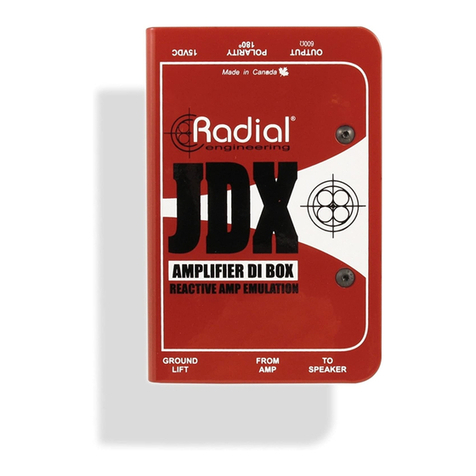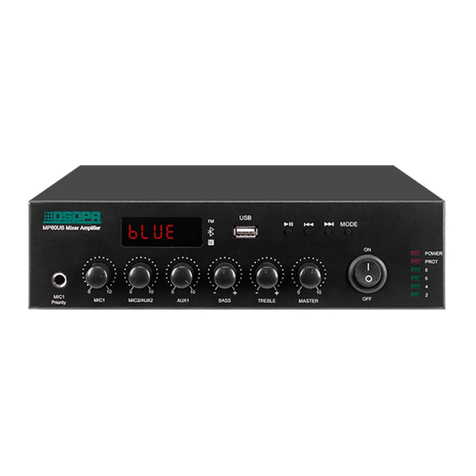Nowsonic USB-PrePen User manual

USB mic preamplifier and
digital audio interface
User manual
Bedienungsanleitung
Mode d‘emploi
Manual del usuario
Podręcznik użytkownika
USB_PRE_PEN_DINA5_01.indd 3 24.10.13 14:52

User manual 4
Bedienungsanleitung 10
Mode d‘emploi 16
Instrucciones de uso 22
Instrukcja obsługi 28
USB_PRE_PEN_DINA5_01.indd 3 24.10.13 14:52

4
USB Pre Pen
User manual
GB www.nowsonic.com
Contents
Introduction
Features
Application
Description of the Controls
Choosing USB Pre Pen as the audio device for your computer
Operation
Troubleshooting
Specifications
Scope of supply
Servicing
Introduction
Thank you very much for purchasing the Nowsonic USB Pre Pen! Now-
sonic USB Pre Pen is an extremely compact USB audio interface for
connecting microphones directly to the computer (Windows oder
Mac). USB Pre Pen amplifies and converts the mic signal and allows
analog audio to be recorded and played back in perfect quality using
an appropriate software.
Thanks to the driver technology, AD/DA conversion up to 48KHz is
performed with low latency. USB Pre Pen is directly supported by the
USB device driver of the operating system and therefore no separate
driver installation is required.
Please take your time to read these instructions carefully in order to
operate USB Pre Pen properly.
Please check the unit after unpacking for any damages. In case the
housing is visibly damaged, please do not operate the unit, but con-
tact your local dealer from whom you have purchased it.
USB_PRE_PEN_DINA5_01.indd 4 24.10.13 14:52

5
USB Pre Pen
User manual
GB
www.nowsonic.com
Features
USB Pre Pen has the following features:
Audio interface with XLR and USB ports
Direct connection of any microphone to the USB port of your
computer
Simple„Plug & Play“ operation with your PC (Windows XP or higher)
or Mac (Mac OS X 10.0 or higher)
Rugged metal enclosure with Velcro strap for fastening at the
mic stand
Internal mic preamp with LED meter for adjusting the mic input gain
+48V phantom power switchable for condenser microphones
Zero latency monitoring while recording
Separate volume knob for the headphone output
Application
In combination with an appropriate microphone and a compatible
audio software, USB Pre Pen is recommended for the following
applications:
Miking and converting vocals
Recording of acoustic instruments and instrument amps
Live recording of a concert or rehearsals
High quality audio playback from the computer
USB_PRE_PEN_DINA5_01.indd 5 24.10.13 14:52

6
USB Pre Pen
User manual
GB www.nowsonic.com
Description of the Controls
Nowsonic USB Pre Pen features an internal XLR socket (1) for connecting
a microphone (not supplied) to the audio interface. On the front, USB
Pre Pen has a 48 V button for phantom power (7), so you can use dyna-
mic as well as condenser microphones. When phantom power is on, the
+48 (8) LED lights up. Please turn off the phantom power when using a
dynamic microphone to reduce power consumption.
Using the supplied USB cable, connect the USB mini connector (10) in
the base plate of USB Pre Pen with your computer (Mac or PC). Next, USB
Pre Pen is automatically detected by the operating system, no separate
driver installation is required. When the communication with the com-
puter is established, the USB LED (9) lights continuously green. In addi-
tion, USB Pre Pen is Bus powered via this connector: there is no need for
an additional power supply.
The MIC GAIN knob (3) on the front controls the mic gain for the inter-
nal pre-amplifier and for the recording software. A three-color LED (2)
serves as a level meter:
if no mic is connected, the LED is not lit.
If the LED lights green, a signal with a level range from -30dB to -12dB
FS is detected.
For maximum audio quality, the mic level should be set so that the LED
remains steady green, flashing yellow at peak levels (-12 to 0dB FS).
If the LED flashes red, lower the Mic Gain. In this case, the 0 dB level
limit is reached and the converted signal is clipping.
Please make sure to check the gain also with the on screen meters of the
recording channel in your host software.
Connect your stereo headphones to the 1/8“ TRS jack (4) on the base
plate. The headphone level is adjusted via the VOLUME knob (5) on the
front of USB Pre Pen. Alternatively, you can connect USB Pre Pen via this
socket to an external monitoring system.
1 2
8
7
3
6
5
9
4
10
USB_PRE_PEN_DINA5_01.indd 6 24.10.13 14:52

7
USB Pre Pen
User manual
GB
www.nowsonic.com
The MONITOR knob on the front is used to balance the playback signal
seamlessly between MIC (direct signal of the mic) and PB (output signal
of the host software in the computer).
The MONITOR knob on the front is used to balance the playback signal
seamlessly between MIC (direct signal of the mic) and PB (output signal
of the host software in the computer).
Choosing USB Pre Pen as the audio device for your computer
After connecting USB Pre Pen to the computer, a plug & play driver of
the OS is installed: no additional driver installation is required.
However, to record the mic signal in your software, you must set USB
Pre Pen as the input and output device in the system settings. Proceed
as follows:
Windows XP and higher
1) Choose„Settings > Control Panel > Sounds, Speech and Audio
devices“.
2) Select„USB audio device“ as the input and output device in the
Audio tab.
or
1) Choose„All Programs > Accessories > Entertainment > Volume
control > Options“.
2) Select„USB audio codec“ as the Mixer device.
Mac OS X 10.0 and higher
1) Choose„System Preferences > Sound“.
2) Select„USB audio codec“ in the„Input“ and„Output“ tabs.
NOTE: Garage Band users should first launch the application and then
connect USB Pre Pen. By this, the USB interface is automatically selected.
Operation
Connect a microphone to the XLR socket of USB Pre Pen. For a con-
denser microphone turn on the +48 button. If needed, you can secure
USB Pre Pen to a microphone stand using the supplied straps. Point
the microphone towards the audio source and turn up the MIC GAIN
knob so that the level LED lights permanently green and flashes yel-
low for signal peaks. If the LED lights red, turn down MIC GAIN.
Connect USB Pre Pen to a free USB port of your computer or laptop
using the supplied USB cable. Next, the plug & play driver is automati-
cally installed and the USB LED lights green.
NOTE: The USB port of your computer / laptop must provide bus pow-
er. If the power of the port is too low, you must use an active USB hub.
The phone jack provides direct monitoring of the mic signal during
recording without any latency. If you are monitoring the mic signal via
the computer, there is, however, an audible latency.
USB_PRE_PEN_DINA5_01.indd 7 24.10.13 14:52

8
USB Pre Pen
User manual
GB www.nowsonic.com
Operation
Turn down the VOLUME knob before connecting the headphone.
Then increase the volume while listening to the mix of the mic signal
and the already recorded tracks. Using the MONITOR knob, you can set
the balance between the microphone and the playback as needed.
NOTE: Make sure that direct monitoring via the audio software is
deactivated. Otherwise you will hear the mic signal doubled by a short
delay.
Troubleshooting
The USB indicator doesn‘t light
Make sure that USB Pre Pen is connected to a USB 1.1 or 2.0 port with
sufficient supply voltage.
In case of doubt use an active USB hub.
No signal in the headphones
Turn up the pre-amplification via the MIC GAIN knob.
Turn up the output level via the VOLUME knob
Set the mix balance to MIC.
The audio signal is distorted
Turn down the pre-amplification via the MIC GAIN knob.
Turn down the output level via the VOLUME knob
The source sounds delayed
Turn off the direct monitoring in the audio software.
Set the mix balance to MIC.
The headphones are not loud enough
Windows: From the„Control Panel“, choose„Sound and Audio
Devices“, select the„Audio“ tab, click„Volume under Sound playback“
and turn up the„Volume“ control.
Mac: From„System Preferences“, choose„Sound“, select the„Output“
tab and turn up the„Output volume“.
USB_PRE_PEN_DINA5_01.indd 8 24.10.13 14:52

9
USB Pre Pen
User manual
GB
www.nowsonic.com
Specifications
Frequency response 20 Hz – 20Khz, +/-1dB
AD/DA conversion 16bit, max. 48KHz (selectable via the
host software)
Digital noise MIC GAIN set to minimum: -81dB FS
MIC GAIN set to maximum: -78dB FS
(20Hz to 20KHz each, A weighted)
Level meter off: <-30dB FS
green: -30 to-12dB FS
yellow: -12 to 0dB FS
red: <-0dB FS
Adjustable gain range 50dB
Computer port USB 1.1 or 2.0 with Bus power
Operating system Windows XP, Vista, 2000, and higher
Mac OS 10.0 and higher
Power supply USB-Bus power, 5V, max. 500mA
Headphone output 1/8“ TRS jack
Scope of supply
USB Pre Pen: 1 pc
USB 2.0 cable, 3m: 1 pc
User manual: 1 pc
Transport bag: 1 pc
Servicing
If you have any question or encounter technical issues, please first
contact your local dealer from whom you have purchased the device.
In case servicing is required, please contact your local dealer. Other-
wise you may contact us directly. Please find our contact data on our
website under www.nowsonic.com.
Legal information
Copyright for this user manual © 2013: Nowsonic
Product features, specifications and availability are subject to change
without prior notice.
Edition v1.0, 10/2013
USB_PRE_PEN_DINA5_01.indd 9 24.10.13 14:52

10
USB Pre Pen
Bedienungsanleitung
DE www.nowsonic.com
Inhalt
Einleitung
Merkmale
Anwendungsbereich
Beschreibung der Bedienelemente
Auswahl von USB Pre Pen als Audiogerät im Computer
Inbetriebnahme
Fehlerbehebung
Spezifikationen
Lieferumfang
Service
Rechtliche Hinweise
Einleitung
Vielen Dank, dass Sie sich für Nowsonic USB Pre Pen entschieden
haben. Nowsonic USB Pre Pen ist ein extrem kompaktes USB-Audio-
Interface zum direkten Anschluss eines Mikrofons an dem Computer
(Windows oder Mac). Das Mikrofonsignal wird dabei im USB Pre Pen
verstärkt und gewandelt und kann im Computer in Verbindung mit
einer geeigneten Software zur hochwertigen Aufnahme und Wieder-
gabe von Audiodaten genutzt werden.
Dank der Treibertechnologie ist eine AD/DA-Wandlung bis 48 kHz bei
geringer Latenz möglich. USB Pre Pen wird direkt von den USB-Geräte-
Treibern im Betriebssystem unterstützt, eine separate Treiber-Installa-
tion ist nicht notwendig.
Bitte nehmen Sie sich Zeit und lesen Sie diese Bedienungsanleitung sorg-
fältig durch, damit Sie USB Pre Pen richtig in Betrieb nehmen können.
Bitte überprüfen Sie das Gerät nach dem Auspacken auf etwaige Schä-
den: Sofern Schäden am Gehäuse sichtbar sind, nehmen Sie das Ge-
rät bitte nicht in Betrieb, sondern wenden sich sofort an Ihren lokalen
Händler, bei dem Sie das Gerät gekauft haben.
USB_PRE_PEN_DINA5_01.indd 10 24.10.13 14:52

11
USB Pre Pen
Bedienungsanleitung
DE
www.nowsonic.com
Merkmale
USB Pre Pen bietet folgende Merkmale:
Audio-Interface mit XLR- und USB-Schnittstelle
Direkter Anschluss von Mikrofonen am USB-Port eines Computers
Einfacher„Plug & Play“-Betrieb mit dem PC (ab Windows XP oder
höher) oder Mac (ab Mac OS X 10.0)
Robustes Metallgehäuse mit Klettbefestigung am Mikrofonstativ
Integrierter Mikrofonvorverstärker mit LED-Anzeige zur Aussteuerung
des Mikrofoneingangs
Schaltbare +48 V Phantomspannung für Kondensatormikrofone
Latenzfreies Monitoring während der Aufnahme
Separater Lautstärkeregler für den Kopfhörerausgang
Anwendungsbereich
In Verbindung mit einem geeigneten Mikrofon und einer kompatib-
len Audio-Software empfiehlt sich USB Pre Pen für folgende Anwen-
dungsbereiche:
Abnahme und Wandlung von Gesang
Aufnahme von akustischen Instrumenten und
Instrumentalverstärkern
Mitschnitt von Konzerten oder im Übungsraum
Hochwertige Audiowiedergabe aus dem Computer
USB_PRE_PEN_DINA5_01.indd 11 24.10.13 14:52

12
USB Pre Pen
Bedienungsanleitung
DE www.nowsonic.com
Beschreibung der Bedienelemente
Nowsonic USB Pre Pen verfügt über einen integrierten XLR-Anschluss
(1), über den sich das Audio-Interface direkt an einem Mikrofon (nicht
im Lieferumfang enthalten) anschließen lässt. USB Pre Pen bietet auf der
Vorderseite einen Taster für 48 V Phantomspeisung (7), sodass sich ne-
ben dynamischen auch hochwertige Kondensatormikrofone betreiben
lassen. Wenn die Phantomspeisung aktiv ist, leuchtet die LED +48 (8):
Deaktivieren Sie die Phantomspeisung im Betrieb mit dynamischen Mi-
krofonen, um den Stromverbrauch zu verringern.
Über die USB-Mini-Buchse (10) in der Bodenplatte verbinden Sie USB
Pre Pen über das mitgelieferte USB-Kabel mit einem Computer (Mac
oder PC). Nachdem Anschluss wird USB Pre Pen automatisch erkannt,
eine zusätzliche Treiberinstallation ist nicht notwendig. Wenn die Kom-
munikation mit dem Computer eingerichtet ist, leuchtet die LED USB
(9) dauerhaft grün. Über diesen Anschluss wird USB Pre Pen auch mit
USB-Bus-Power gespeist: Eine separate Stromversorgung ist nun nicht
vorgesehen.
Zur Aussteuerung des Mikrofons auf den integrierten Vorverstärker und
damit auf die Aufnahme-Software dient der Regler MIC GAIN (3) auf
der Vorderseite. Die Aussteuerung wird über eine dreifarbige LED (2)
dargestellt:
Wenn kein Mikrofon angeschlossen ist, leuchtet die LED nicht.
Wenn die LED grün leuchtet, liegt ein Signal im Pegelbereich von 30
bis -12 dB FS an.
Für einen optimalen Pegel sollten Sie das Mikrofonsignal so aussteu-
ern, dass die LED vornehmlich grün und bei Pegelspitzen gelb (-12
bis 0 dB FS) aufleuchtet.
Sofern die LED rot leuchtet, senken Sie MIC GAIN ab: In diesem Fall
wird die Pegelgrenze 0 dB erreicht und das gewandelte Signal über-
steuert.
Überprüfen Sie die Aussteuerung in jedem Fall auch mit Hilfe der On-
screen-Pegelanzeigen für den entsprechenden Aufnahmekanal in der
Host-Software.
1 2
8
7
3
6
5
9
4
10
USB_PRE_PEN_DINA5_01.indd 12 24.10.13 14:52

13
USB Pre Pen
Bedienungsanleitung
DE
www.nowsonic.com
Über die 3,5 mm TRS-Miniklinkenbuchse (4) in der Bodenplatte schlie-
ßen Sie einen Stereokopfhörer an: Die Aussteuerung der Kopfhörer-
Lautstärke erfolgt über den Regler VOLUME (5) auf der Vorderseite von
USB Pre Pen. Alternativ können Sie USB Pre Pen über diese Buchse auch
an ein externes Abhörsystem anschließen
Über den Regler MONITOR auf der Frontseite stellen Sie das Mischungs-
verhältnis für die Mini-Klinkenbuchse (4) stufenlos zwischen MIC (Di-
rektsignal des Mikrofons) und PB (Ausgangssignal der Host-Software im
Computer) ein.
Auswahl von USB Pre Pen als Audiogerät im Computer
Nach dem Anschluss von USB Pre Pen wird automatisch ein interner
Plug & Play –Treiber des Betriebssystems installiert: Eine weitere Treiber-
Installation ist nicht notwendig.
Allerdings müssen Sie USB Pre Pen als Ein- und/oder Ausgabegerät in
der Systemsteuerung eintragen, um das Mikrofonsignal in einer Audio-
Software aufnehmen zu können. Gehen Sie wie folgt vor:
Windows XP und höher
1) Wählen Sie„Einstellungen > Systemsteuerung > Sounds und
Audiogeräte“.
2) Wählen Sie„USB Audiogerät“ im Reiter Audio für die Soundwieder-
gabe und –aufnahme.
or
1) Wählen Sie„Programme > Zubehör > Unterhaltungsmedien >
Lautstärke > Optionen“.
2) Wählen Sie„USB Audio Codec“ als Mixer-Gerät.
Mac OS X 10.0 und höher
1) Wählen Sie„Systemeinstellungen > Ton “.
2) Wählen Sie„USB Audio Codec“ in den Reitern„Eingabe“ und„Ausgabe“.
ANMERKUNG: Wenn Sie Garage Band benutzen, starten Sie das Pro-
gramm zuerst und schließen erst dann USB Pre Pen an: Das USB-Inter-
face wird nun automatisch angewählt.
Inbetriebnahme
Schließen Sie ein Mikrofon an der XLR-Steckverbindung von USB Pre
Pen an. Sofern es sich um ein Kondensatormikrofon handelt, aktivieren
Sie den Schalter +48. Bei Bedarf können Sie USB Pre Pen über die mit-
gelieferten Haltebänder direkt am Mikrofonständer befestigen. Rich-
ten Sie das Mikrofon auf die Schallquelle und drehen Sie den Regler
MIC GAIN auf, sodass die Pegel-LED vornehmlich grün und bei Spit-
zenpegel kurz gelb aufleuchtet. Wenn die LED rot leuchtet, verringern
Sie die Aussteuerung.
Schließen Sie USB Pre Pen nun mit dem mitgelieferten USB-Kabel an
einem freien USB-Port Ihres Computers oder Laptops an. Nach dem
Anschluss wird der Plug & Play-Treiber automatisch installiert und die
USB-LED sollte grün leuchten.
USB_PRE_PEN_DINA5_01.indd 13 24.10.13 14:52

14
USB Pre Pen
Bedienungsanleitung
DE www.nowsonic.com
ANMERKUNG: Der USB-Port Ihres Computers/Laptops muss in jedem
Fall Bus-Power zur Verfügung stellen. Sofern die Leistung des Ports zu
gering ist, müssen Sie einen aktiven USB-Hub zwischenschalten.
Die Kopfhörerbuchse ermöglicht ein direktes Abhören des Mikrofon-
signals während der Aufnahme ohne jegliche Verzögerung: Wenn Sie
das Mikrofonsignal dagegen über den Computer abhören, kommt es
zu einer hörbaren Latenz.
Drehen Sie den Regler VOLUME zurück, bevor Sie den Kopfhörer
anschließen. Dann heben Sie die Lautstärke an, während Sie bereits
aufgenommene Spuren aus der Audio-Software zusammen mit dem
Mikrofonsignal abhören. Über den Regler MONITOR stellen Sie das
Lautstärkeverhältnis zwischen Mikrofon und Playback nach Bedarf ein.
ANMERKUNG: Deaktivieren Sie in jedem Fall das Software-Monito-
ring in der Audio-Software. Andernfalls hören Sie das Mikrofonsignal
doppelt und mit einer kurzen Verzögerung
Fehlerbehebung
Die USB-LED leuchtet nicht auf
Stellen Sie sicher, dass USB Pre Pen an einem USB 1.1- oder USB 2.0-An-
schluss mit ausreichender Versorgungsspannung angeschlossen ist.
Verwenden Sie im Zweifelsfall einen aktiven USB-Hub.
Kein Audiosignal im Kopfhörer
Heben Sie die Vorverstärkung über den Regler MIC GAIN an.
Heben Sie den Ausgabepegel über den Regler VOLUME an.
Stellen Sie die Mix-Balance auf MIC ein.
Das Audiosignal verzerrt
Senken Sie die Vorverstärkung über den Regler MIC GAIN ab.
Senken Sie den Ausgabepegel über den Regler VOLUME an.
Schallquelle klingt verzögert
Deaktivieren Sie das Direct-Monitoring in der Audio-Software.
Stellen Sie die Mix-Balance auf MIC ein.
Die Kopfhörer sind nicht laut genug
Windows: Öffnen Sie in der Systemsteuerung den Reiter„Sound- und
Audiogeräte”, wählen Sie die Registerkarte„Audio“ und klicken Sie
unter„Soundwiedergabe“ auf den Eintrag„Lautstärke“: Heben Sie den
Lautstärkeregler an.
Mac: Öffnen Sie in den Systemeinstellungen das Register„Ton“
und wählen Sie dort den Reiter„Ausgang“: Heben Sie den Laut-
stärkeregler an.
USB_PRE_PEN_DINA5_01.indd 14 24.10.13 14:52

15
USB Pre Pen
Bedienungsanleitung
DE
www.nowsonic.com
Spezifikationen
Frequenzgang 20 Hz – 20 kHz, +/- 1 dB
AD/DA-Wandlung 16 Bit, bis 48 kHz (Auswahl über die
Host-Software)
Digitales Grundrauschen Minimale Einstellung für MIC GAIN: -81 dB FS
Maximale Einstellung für MIC GAIN: -78 dB FS
(jeweils 20 Hz bis 20 kHz, A-gewichtet)
Pegelanzeige Aus: <-30 dB FS
Grün: -30 bis -12 dB FS
Gelb: -12 bis 0 dB FS
Rot: > 0 dB FS
Verstärkungsbereich 50 dB
Computer-Schnittstelle USB 1.1 oder 2.0 mit Bus Power
Betriebssystem ab Windows XP, Vista oder 2000
ab Mac OS 10.0 oder höher
Stromversorgung USB-Bus-Power, 5 V, max. 500 mA
Kopfhörerausgang 3,5 mm TRS Miniklinke
Lieferumfang
USB Pre Pen: 1x
USB 2.0 Kabel, 3 Meter: 1x
Bedienungsanleitung: 1x
Transporttasche: 1x
Service
Wenn Sie Probleme oder technische Fragen haben, wenden Sie sich bit-
te zuerst an Ihren lokalen Händler, bei dem Sie das Gerät gekauft haben.
Bei einem Service-Fall wenden Sie sich bitte ebenfalls an Ihren lokalen
Händler. Andernfalls können Sie uns auch direkt kontaktieren. Sie finden
unsere Kontaktdaten auf unserer Webseite unter www.nowsonic.com.
Rechtliche Hinweise
Copyright für diese Bedienungsanleitung © 2013: Nowsonic
Produktmerkmale, Spezifikationen und die Verfügbarkeit können ohne
vorherige Ankündigung geändert werden.
Ausgabe v 1.0, 10/2013
USB_PRE_PEN_DINA5_01.indd 15 24.10.13 14:52

16
USB Pre Pen
Mode d‘emploi
FR www.nowsonic.com
Sommaire
Introduction
Caractéristiques
Domaine d‘application
Description des entrées
Sélection de l‘USB Pre Pen comme interface audio dans l‘ordinateur
Mise en service
Dépannage
Caractéristiques techniques
Contenu
Maintenance
Mentions légales
Introduction
Merci beaucoup d‘avoir choisi l‘USB Pre Pen Nowsonic. L‘USB Pre Pen
Nowsonic est une interface audio-USB extrêmement compacte pour
brancher directement un microphone à votre ordinateur (Windows ou
Mac). Le signal du microphone est amplifié et converti dans l‘USB Pre
Pen et, en conjonction avec un logiciel approprié pour l‘enregistrement
et la lecture à haute qualité de données audio, peut être utilisé dans
l‘ordinateur.
Grâce à la technologie du pilote USB Pre Pen, une conversion A/N-N/A
à 48 kHz avec faible latence est possible. L‘USB Pre Pen est directe-
ment pris en charge par le pilote de périphérique USB du système
d‘exploitation, aucune installation de pilote propre n‘est nécessaire.
Veuillez prendre le temps de lire attentivement ce mode d‘emploi afin
de pouvoir assurer une mise en service correcte de l‘USB Pre Pen.
Veuillez contrôler tout éventuel dommage de l‘unité au déballage : si
le boîtier présente des dommages visibles, ne mettez pas l‘unité en
service mais contactez immédiatement le revendeur chez qui vous
l‘avez achetée.
USB_PRE_PEN_DINA5_01.indd 16 24.10.13 14:52

17
USB Pre Pen
Mode d‘emploi
FR
www.nowsonic.com
Caractéristiques
L‘USB Pre Pen offre les fonctionnalités suivantes :
Interface audio avec ports XLR et USB
Connexion directe de micros au port USB d‘un ordinateur
Fonctionnement simple, « plug and play », avec votre PC (Windows
XP ou supérieur) ou Mac (Mac OS X 10.0 ou supérieur)
Boîtier métallique robuste avec fixation velcro sur le pied de micro
Préampli microphone intégré avec indicateur de niveau à DEL de
l‘entrée microphone
Alimentation fantôme +48 V commutable les micros à condensateur
Écoute de contrôle sans latence durant l‘enregistrement
Contrôle du volume séparé pour la sortie casque
Domaine d‘application
En conjonction avec un microphone adapté et un logiciel audio com-
patible, l‘USB Pre Pen est recommandé pour les applications suivantes:
Capture et conversion de chant
Enregistrement d‘instruments acoustiques et d‘amplificateurs
d‘instruments
Enregistrement de concerts ou en salle de répétition
Lecture audio de haute qualité à partir de l‘ordinateur
USB_PRE_PEN_DINA5_01.indd 17 24.10.13 14:52

18
USB Pre Pen
Mode d‘emploi
FR www.nowsonic.com
Description des entrées
L‘USB Pre Pen Nowsonic dispose d‘un connecteur XLR intégré (1) grâce
auquel l‘interface audio peut être directement connectée à un micro-
phone (non fourni). L‘USB Pre Pen possède en face avant un commuta-
teur d‘alimentation fantôme 48 V (7), pour fonctionner non seulement
avec les microphones dynamiques mais aussi avec les électrostatiques
(« à condensateur ») de haut de gamme. Lorsque l‘alimentation fantôme
est activée, le voyant +48 (8) est allumé : coupez l‘alimentation fantôme
lorsque vous utilisez des microphones dynamiques pour réduire la con-
sommation électrique.
Connectez votre ordinateur (Mac ou PC) au mini-port USB (10) sous
l‘USB Pre Pen via le câble USB fourni. Après connexion, l‘USB Pre Pen
est automatiquement reconnu, aucune installation de pilote supplé-
mentaire n‘est nécessaire. Lorsque la communication est établie avec
l‘ordinateur, le voyant USB (9) s‘allume en vert. Cette connexion fournit
également à l‘USB Pre Pen une alimentation par le bus USB : une alimen-
tation séparée n‘est pas prévue.
La commande MIC GAIN (3) de la face avant sert à contrôler le niveau
du microphone dans le préamplificateur intégré et donc dans le logiciel
d‘enregistrement. La modulation est représentée par une diode à trois
couleurs (2) :
Si aucun microphone n‘est branché, le voyant ne s‘allume pas.
Le voyant est allumé en vert en cas de signal d‘un niveau compris
entre 30 et -12 dB FS.
Pour un niveau optimal, réglez le signal du microphone de sorte
que le voyant soit principalement vert et ne vire au jaune que sur les
crêtes de niveau (-12 à 0 dB FS).
Si le voyant s‘allume en rouge, baissez MIC GAIN: dans ce cas, la
limite de niveau de 0 dB est atteinte et le signal converti sature.
Vérifiez toujours le niveau en utilisant à l‘écran les indicateurs de
niveau du canal d‘enregistrement correspondant dans le logiciel hôte.
1 2
8
7
3
6
5
9
4
10
USB_PRE_PEN_DINA5_01.indd 18 24.10.13 14:52

19
USB Pre Pen
Mode d‘emploi
FR
www.nowsonic.com
Vous pouvez brancher un casque stéréo à la prise mini-jack 3,5 mm
3 points (TRS) de dessous : le contrôle du volume du casque se fait par
la commande VOLUME (5) sur le devant de l‘USB Pre Pen. Sinon, vous
pouvez aussi connecter l‘USB Pre Pen à un système d‘écoute de contrôle
externe via cette prise.
Avec la commande MONITOR de la face avant, vous réglez en continu
la balance de mixage pour la prise mini-jack (4) entre MIC (signal direct
du microphone) et PB (signal sortant du logiciel hôte de l‘ordinateur).
Sélection de l‘USB Pre Pen comme interface audio dans l‘ordinateur
Après la connexion de l‘USB Pre Pen, un pilote Plug & Play interne du sys-
tème d‘exploitation sera automatiquement installé : aucune installation
d‘autre pilote n‘est nécessaire.
Cependant, vous devez sélectionner l‘USB Pre Pen comme interface
d‘entrée et/ou de sortie dans le panneau de configuration du système
pour pouvoir enregistrer le signal du microphone dans un logiciel audio.
Procédez comme suit :
Windows XP et supérieur
1) Sélectionnez « Démarrer > Panneau de configuration > Sons et
périphériques audio ».
2) Dans l‘onglet Audio, sélectionnez « Périphérique audio USB » pour
l‘enregistrement et la lecture audio.
ou
1) Sélectionnez « Tous les programmes > Accessoires > Divertisse-
ment > Contrôle du volume > Options ».
2) Sélectionnez « USB Audio Codec » comme périphérique de mixage.
Mac OS X 10.0 et supérieur
1) Sélectionnez « Préférences système > Son ».
2) Sélectionnez « USB Audio Codec » dans les onglets « Entrée » et « Sortie ».
REMARQUE : Pour les utilisateurs de Garage Band: Ouvrir Garage Band
avant de brancher le microphone pour sélectionner automatiquement
le périphérique USB.
Mise en service
Branchez un microphone au connecteur XLR de l‘USB Pre Pen. Si c‘est
un microphone électrostatique (à condensateur), activez le commu-
tateur +48. Si nécessaire, vous pouvez monter directement l‘USB Pre
Pen sur le pied de micro à l‘aide des sangles fournies. Faites pointer le
microphone vers la source sonore et réglez la commande MIC GAIN
de sorte que le voyant de niveau s‘allume principalement en vert et
brièvement en jaune sur les crêtes de niveau. Si le voyant s‘allume en
rouge, baissez le niveau.
Connectez maintenant l‘USB Pre Pen à un port USB libre de votre or-
dinateur de bureau ou portable au moyen du câble USB fourni. Après
la connexion, le pilote Plug & Play sera automatiquement installé et le
voyant USB doit s‘allumer en vert.
USB_PRE_PEN_DINA5_01.indd 19 24.10.13 14:52

20
USB Pre Pen
Mode d‘emploi
FR www.nowsonic.com
REMARQUE: le port USB de votre ordinateur/portable doit toujours
fournir une alimentation de bus. Si l‘alimentation du port est trop faib-
le, vous devez passer par un concentrateur (hub) USB actif (alimenté).
La prise casque permet une écoute de contrôle directe et sans au-
cune latence du signal du microphone pendant l‘enregistrement : si
vous écoutez le signal du microphone en même temps que celui de
l‘ordinateur, un temps de latence est cependant audible.
Baissez la commande VOLUME avant de brancher le casque. Ensuite,
montez le volume pendant que vous écoutez les pistes déjà enregist-
rées dans le logiciel audio en même temps que le signal du micropho-
ne. Avec la commande MONITOR, réglez si nécessaire la balance de
volume entre le signal du microphone et le signal de lecture.
REMARQUE: désactivez toujours l‘écoute de contrôle par logiciel dans
le logiciel audio. Sinon, vous entendez deux fois le signal du micropho-
ne, avec un court délai.
Dépannage
Le voyant USB ne s‘allume pas
Vérifier que l‘USB Pen Pre est connecté à un port USB 1.1 ou USB 2.0
offrant une tension d‘alimentation suffisante.
En cas de doute, intercaler un concentrateur (hub) USB actif (alimenté).
Pas de son dans le casque d’écoute
Augmenter la préamplification avec la commande MIC GAIN.
Monter le bouton VOLUME ou MIC GAIN du microphone.
Régler la balance de mixage du micro.
Le son est distordu
Baisser la préamplification avec la commande MIC GAIN.
Baisser le niveau de sortie avec la commande VOLUME.
La source semble retardée
Désactiver l‘écoute de contrôle directe dans le logiciel audio.
Régler la balance de mixage du micro.
Le volume des écouteurs n’est pas assez fort
Windows : ouvrir « Sons et périphériques audio » dans le panneau de
configuration, sélectionner l‘onglet « Audio » et cliquer sur « Volume »
dans « Lecture audio » : monter la commande de volume.
Mac : Depuis les « Préférences Système », choisir « Son », choisir
l’onglet « Sortie » et augmenter le volume de sortie.
USB_PRE_PEN_DINA5_01.indd 20 24.10.13 14:52

21
USB Pre Pen
Mode d‘emploi
FR
www.nowsonic.com
Caractéristiques techniques
Réponse en fréquence 20 Hz – 30 kHz, +/- 1 dB
Conversion A/N-N/A 16 bits, jusqu’à 48 kHz
(choix dans le logiciel hôte)
Bruit de fond numérique Réglage du MIC GAIN minimum: -81 dB FS
Réglage du MIC GAIN maximum: -78 dB FS
(20 Hz á 20 kHz, pondéré en A)
Affichage du niveau Éteint : <-30 dB FS
Vert : -30 -12 dB FS
Jaune : -12 0 dB FS
Rouge : > 0 dB FS
Plage de gain réglable 50 dB
Interface d‘ordinateur USB 1.1 ou 2.0 avec alimentation du bus
Système d‘exploitation à partir de Windows XP, Vista ou 2000
Mac OS 10.0 et supérieur
Alimentation alimentation par le bus USB, 5 V,
500 mA, maximum
Sortie écouteurs mini-jack 3,5 mm 3 points (TRS)
Contenu
USB Pre Pen: 1
Câble USB 2.0, 3 mètres : 1
Mode d‘emploi : 1
Sacoche de transport : 1
Maintenance
Si vous avez des questions ou des problèmes techniques, veuillez
d‘abord contacter le revendeur chez qui vous avez acheté l‘appareil.
Pour toute réparation, veuillez également contacter votre revendeur. Si
cela n‘est pas possible, vous pouvez aussi nous contacter directement.
Nos coordonnées se trouvent sur notre site Web www.nowsonic.com.
Mentions légales
Ce mode d‘emploi est sous copyright © 2013 : Nowsonic
Les fonctionnalités, caractéristiques techniques et disponibilité du pro-
duit peuvent être modifiées sans préavis.
Édition v1.0, 10/2013
USB_PRE_PEN_DINA5_01.indd 21 24.10.13 14:52
Table of contents
Languages:
Other Nowsonic Amplifier manuals


